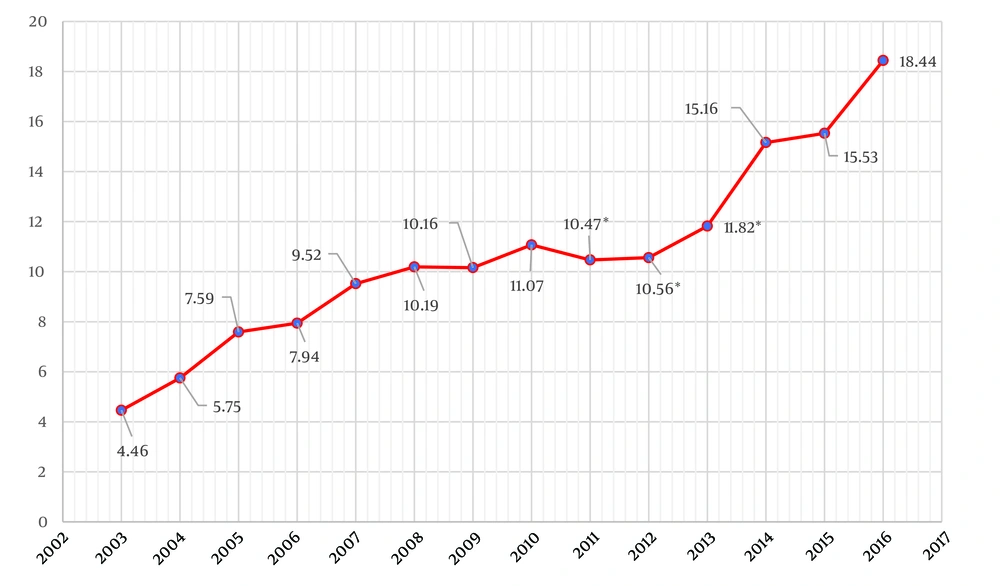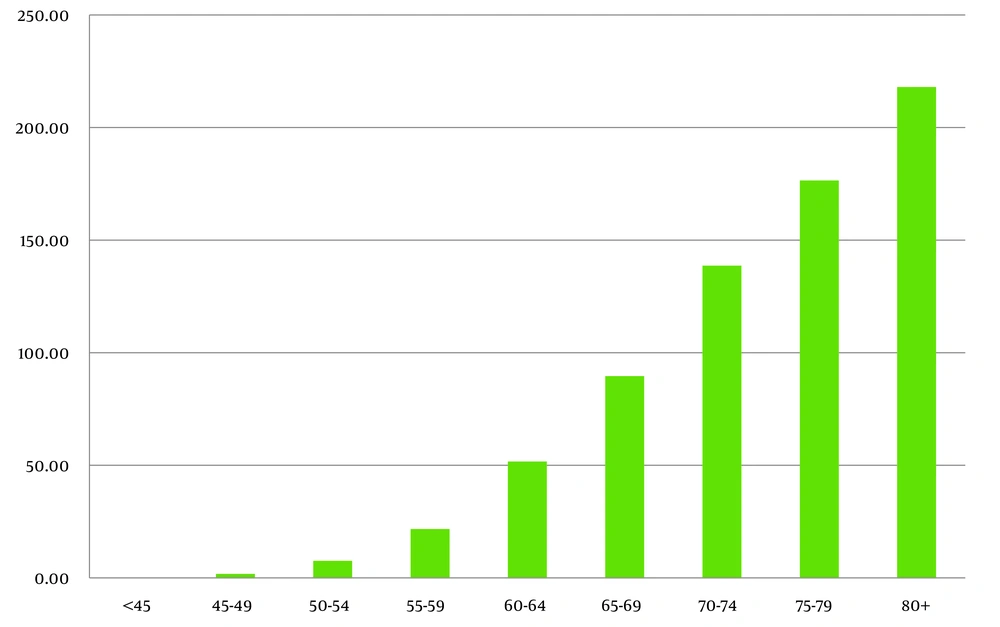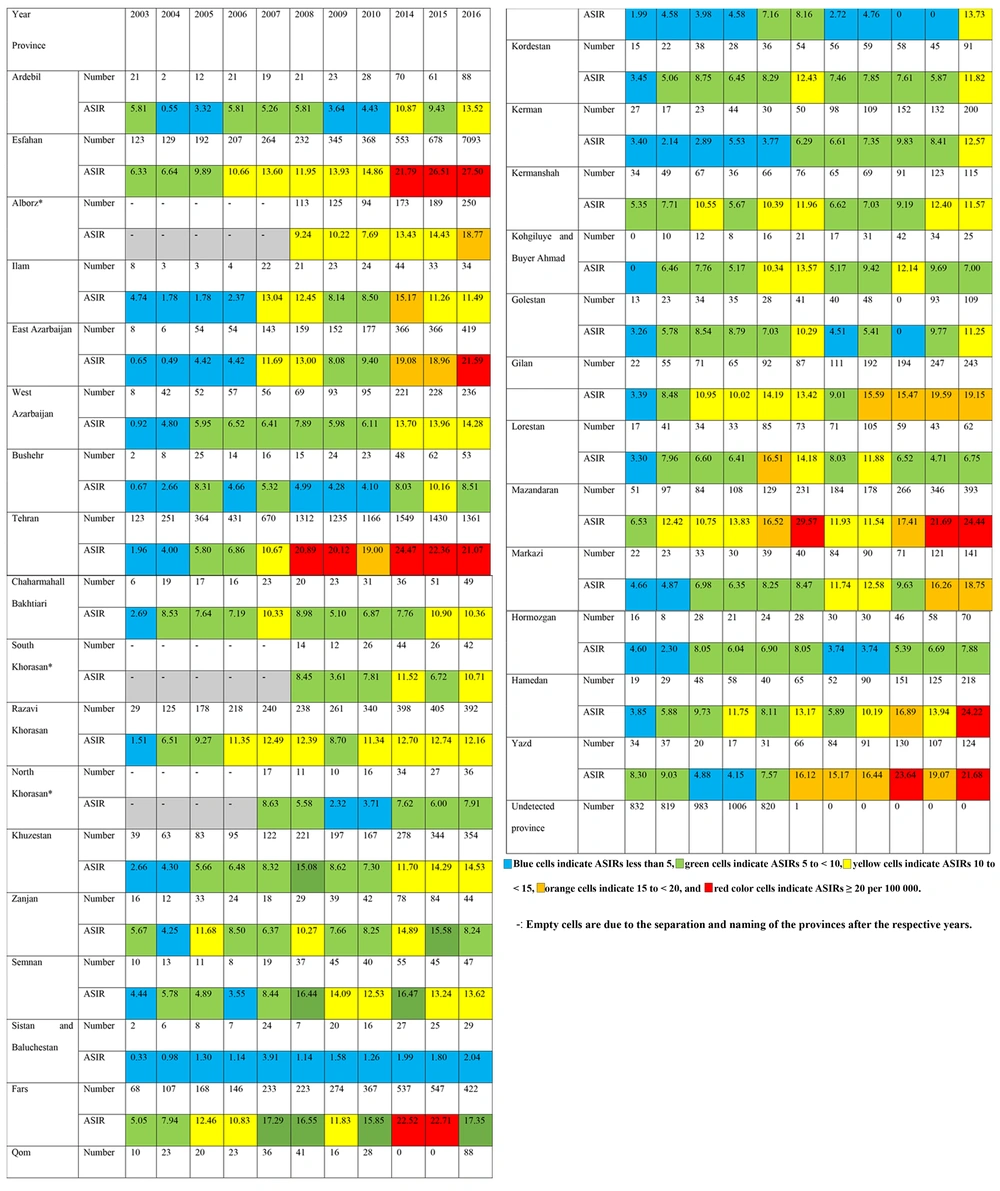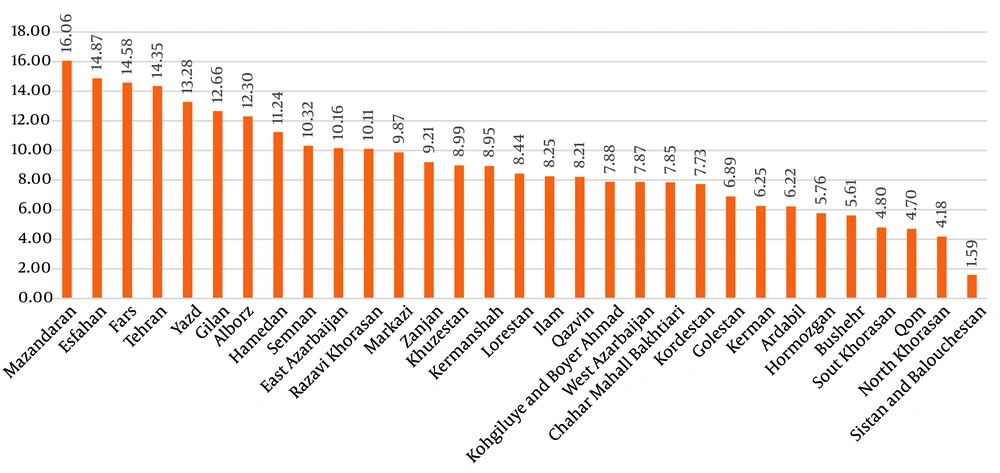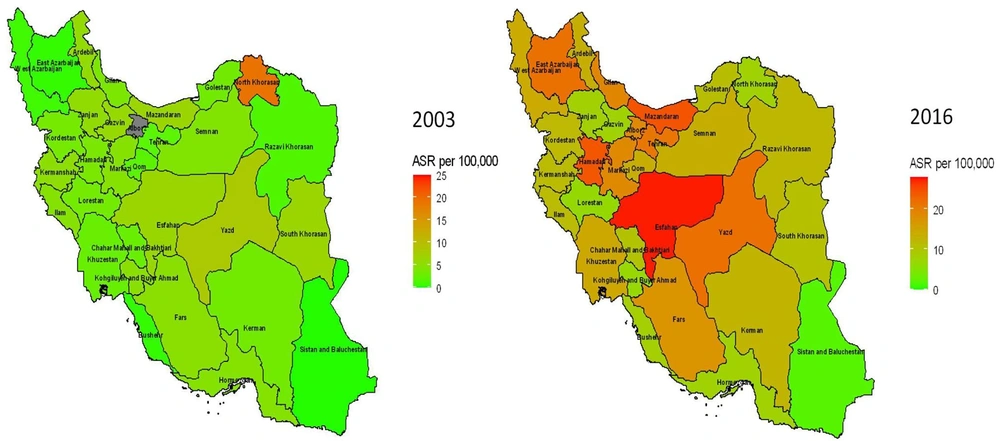1. Background
Prostate cancer is introduced as the second most common cancer of men after lung cancer; 127 610 6 new cases were reported in 2018, which caused 3.8% of all cancer-related deaths in men (1, 2). It is estimated that 2 293 818 new cases will be found by 2040 and only a small increase in mortality will happen (3).
In men, the risk of prostate cancer development is 11.6% (4, 5) and it is a major public health concern, but it should be noted that its incidence and mortality are associated with its determining factors. For instance, higher age is an important risk factor for the development of prostate cancer; also, family history, smoking history, increasing height, higher BMI, higher intake of calories, calcium, and alpha-linolenic acid are reported to be significantly associated with the evaluated risk of fatal prostate cancer, whereas a higher level of physical activity is reported as a preventive factor (6).
Notably, the incidence rates of African-American men are higher than Caucasian men and the mortality rate is almost doubled. This finding indicates that the underlying mechanisms of prostate cancer are intricate and still need to be understood. It is hypothesized that genetic, social, and environmental reasons are also effective in the incidence rates (7).
In Iran, a detailed understanding of prostate cancer epidemiology is of great value for health administrators and helps in the early detection and prevention of the disease. Epidemiological studies may also provide essential information for assessing the disease disparities in different provinces of the country.
2. Objectives
In the present study, we aimed at reporting national and subnational incidence of prostate cancer in Iran between 2003 and 2016.
3. Methods
The incidence of prostate cancer was assessed in Iran and its 31 provinces between 2003 and 2016 according to pathology-confirmed cases of the national cancer registry system. This is the analysis of the last updated data from the cancer registry system of Iran Ministry of Health and Medical Education. Iranian cancer registry system has been developed systemically since 2000, using software-based data from all pathology centers with coverage of 100% of the country's provinces (8). In the Iranian cancer registry system, cancer types are coded according to the International Classification of Diseases for Oncology, 3rd edition (ICD-O-3) (9), and the topography of cancers is determined based on the International Classification of Diseases, 10th edition (ICD-10). In this system, prostate cancer is detectable by C61, the malignant neoplasm of the prostate (10).
In the next step, all national data were entered into an Excel software file. To simplify the assessments of age-specific epidemiological rates through populations with diverse age structures, it is beneficial to determine short statistics that take away the effects of variation in age composition. To keep the comparability of the incidence rates in different societies, the World Health Organization (WHO) has introduced a new standard population as a basis to facilitate epidemiological research worldwide (11).
A census of data from the National Cancer Registry Center was used to accomplish this study. The population of the whole country and each province were obtained from the website of the Iran Statistics Center (12). Then, age-standardized incidence rates (ASIRs) per 100 000 per annum were calculated for the country and all provinces according to the age groups, and incident year. Age-standardized incidence rates were calculated by a direct age-standardization method based on the WHO standard population, using STATA software version 12. To make epidemiological rates easier to compare through populations with diverse age compositions, it is useful to determine short statistics that remove the effects of age variation. Because of the importance of the comparability of the incidence rates in different populations, WHO has presented a new standard population to facilitate epidemiological studies (11).
Due to a lot of data recording defects from 2010 to 2013, the available data did not have the necessary quality to use in this study. Therefore, we decided to do a time series analysis for this period.
To find an appropriate primary model, sc and pac graphs were used. The likelihood ratio test (Lrtest) was carried out to compare the results. The autoregressive integrated moving average (ARIMA) model was used as the most common kind of model for predicting time series events (13). Autoregressive integrated moving average (pdq) is comprised of autoregressive (p), difference (d), and moving average (q). Seasonal trend in the disease of this model is presented as SARIMA (p d q) (P D Q)s, where P, D, and Q are the same components as before, with the difference that they are considered for the seasonal delay and the component s is the time corresponding to one data in the previous year, which is equivalent to 12 in monthly data.
4. Results
The number of incident prostate cancer cases in Iran was 49 188 between 2003 and 2016. The ASIR of prostate cancer showed an increasing trend from 4.46 per 100 000 in 2003 to 18.44 per 100 000 in 2016 (Figure 1). The incidence rate of prostate cancer increased with age and the highest ASIR of prostate cancer was observed in the age group of more than 80 years old (Figure 2).
Mazandaran (29.57 per 100 000 in 2008), Esfahan (27.5 per 100 000 in 2016 and 26.51 per 100 000 in 2015), and Tehran (24.47 per 100 000 in 2014) are provinces with the highest reported ASIRs in recent years. Detailed ASIRs of prostate cancer in each province are summarized in Figure 3. The mean of ASIR of prostate cancer in the years of the study shows that Mazandaran province with the highest ASIR of 16.06 per 100 000 was the riskiest area in Iran followed by Esfahan (14.87 per 100 000) and Fars (14.58 per 100 000), while Sistan and Baluchestan province had the lowest mean of ASIR (1.59 per 100 000) from 2003 to 2016 in the country (Figure 4 and Figure 5).
5. Discussion
Cancer is the third leading cause of death in Iran (14). However, few studies have been conducted on the epidemiology of cancer in developing countries such as Iran. In Iran, national and subnational policymakers need to know basic cancer epidemiology in each area to develop comprehensive cancer prevention plans. This pathology-based study, using national data from the Ministry of Health, has examined the exact incidence of prostate cancer in all provinces of the country and provides vital information about the trend of prostate cancer incidence in the whole country and all provinces in each year from 2003 to 2016.
The annual incidence of age-adjusted prostate cancer is reported to be 152 per 100 000 men, but the incidence varies widely between different races and ethnicities. For example, prostate cancer is now the second leading cause of cancer death in the United States, affecting 1 in 7 men (6). Approximately, 1 in 36 men in the United States dies each year from prostate cancer (2). The annual incidence of prostate cancer in Caucasian men is 144.9 per 100 000, while for African-American men, it is 228.5 per 100 000. Alaskan Native Americans have the lowest incidence (77.8 per 100 000) in the Americas (6).
Prostate cancer most often affects older men, with 60% of patients being men over 65 years of age or older, and the average age of patients at the time of diagnosis is estimated at 67 years (2).
According to WHO, in 2012, the incidence of this disease in East and South Asia was 10.5% and 4.5%, respectively (6). Although the incidence of prostate cancer in Asia is lower than in Western countries, the prevalence of prostate cancer in Asian countries has increased dramatically in the last few decades. Prostate cancer is currently the 6th most common cancer in Asian men and West Asia has the highest of all cancers and South Asia has the lowest (15).
So far, there are no accurate statistics on the prevalence of prostate cancer in Iran, but in limited studies, its prevalence is lower than in Western and European countries. In Iranian men, prostate cancer is the third most common visceral cancer and the 7th deadliest cancer (16, 17).
According to the results of this study, the raw number of patients and ASIR prostate cancer in Iran shows an increasing trend from 2003 to 2016. Changing the ASIR of prostate cancer from 4.46 in 2003 to 18.44 per 100 000 in 2016 indicates an increasing trend of 4-fold. This increasing trend is following the results of a systematic review and meta-analysis on the incidence of prostate cancer in Iran. The researchers showed a significantly higher pooled estimate of the ASIR (11 per 100 000) from 2004 to 2012 compared with those conducted from 1996 to 2003 (6.3 per 100 000) (P < 0.001) (18).
A noteworthy point in the study of the incidence in the provinces of the country is the presence of high ASIR levels of prostate cancer at the end of the study period (2016) in some provinces, including Esfahan 27.50, Mazandaran 24.44, East Azerbaijan 21.59, and Tehran 21.07 per 100 000, indicating an increased risk of prostate cancer in the coming years in Iran.
Although Iran has a mild incidence of prostate cancer compared to other parts of the world, the results of this study show that the incidence trend of prostate cancer in Iran has a different pattern of changes in the world. This trend can be due to the lack of a systematic screening program in Iran, which underscores the need for a regular and comprehensive screening program as well as the development of treatment guidelines.
Investigating the risk factors of prostate cancer in high-risk provinces is valuable to prevent and control the increasing trend of prostate cancer incidence.
Worldwide, factors such as population growth, population aging, and changes in the incidence and mortality rates highlight the importance of paying attention to urological cancers, including prostate cancer; as such cancers are more common in older age groups in countries. In developing countries like Iran, where life expectancy is higher, the burden of these malignancies may increase significantly by increasing the mean age of the population. Common and controllable risk factors such as smoking and obesity in prostate cancer underscore the importance of preventive programs in this regard.
5.1. Conclusions
Although the increase in coverage of data recording and greater access to diagnostic tests during these years is effective in the reported ASIRS, the steep slope in the incidence trend of prostate cancer compared to other cancers in Iran (8) shows its capacity to become one of the health problems in the future that emphasize the duty of the health officials to reduce the serious consequences of the disease in the coming years by evaluating risk factors, implement screening programs, and develop national therapeutic guidelines across the country.

